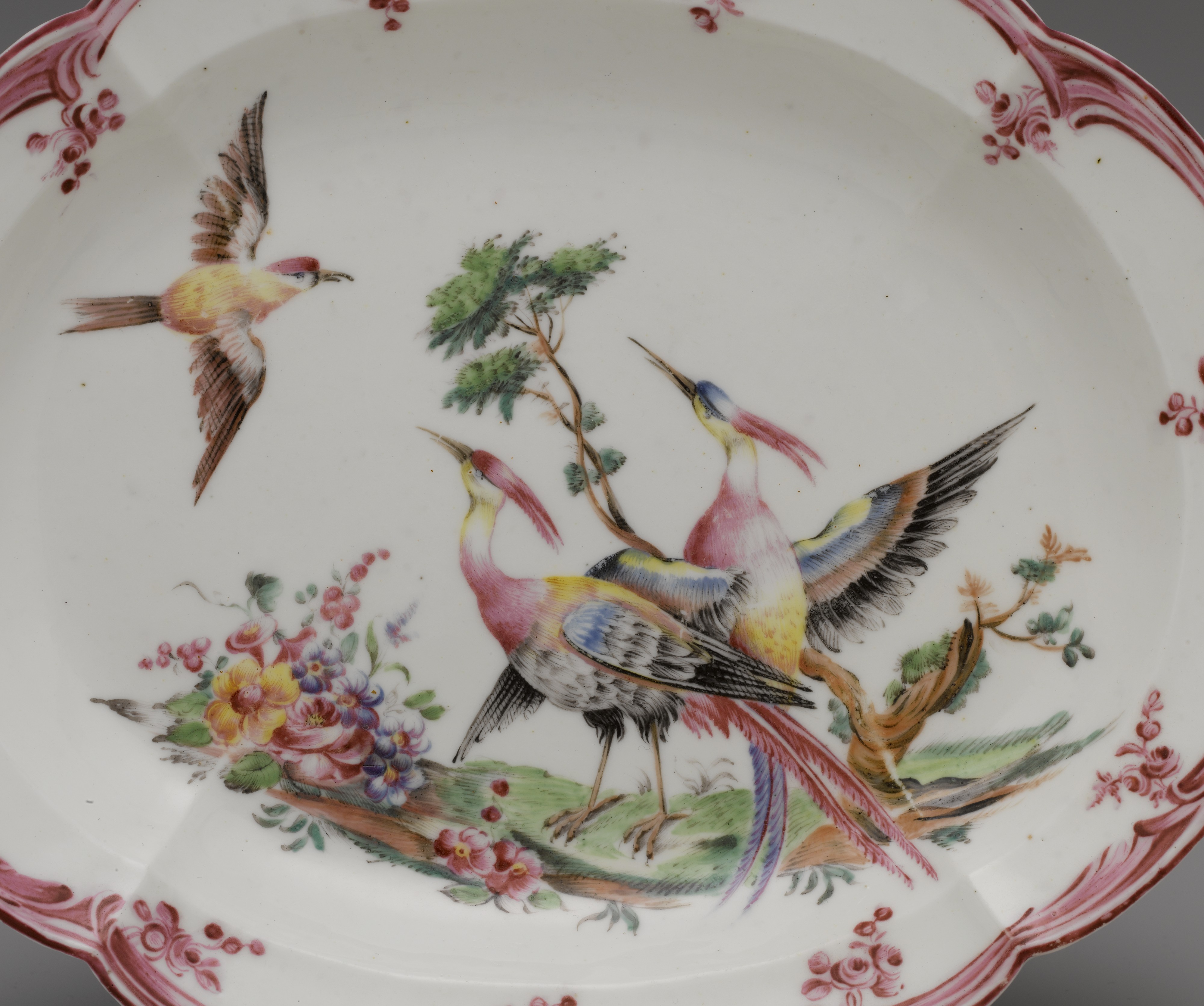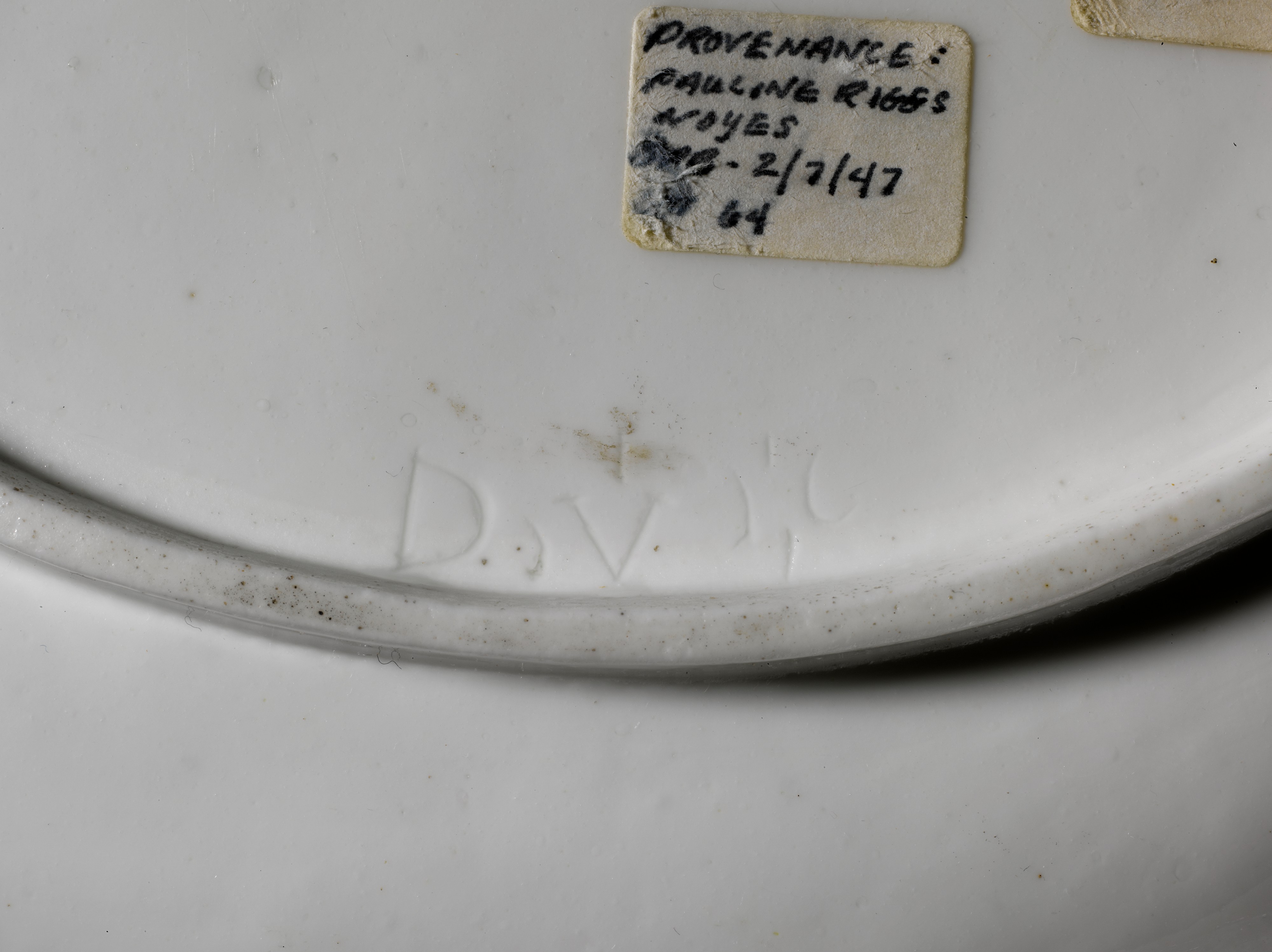Stand
Factory Mennecy
Not on view
The Mennecy factory produced a limited number of tablewares, most of which appear to have been made as independent objects rather than as part of sets united by coordinated painted decoration. Like the Saint-Cloud and Chantilly factories, Mennecy did not attempt to produce entire dinner services, which were extremely expensive to create due to the number of forms required. In addition, the production of large objects, such as soup tureens, platters, and bowls for punch or for salad that were standard components of services, was beyond the factory’s technical capability. However, Mennecy made a limited number of less ambitious, independent dining wares, including wine coolers,[1] sauceboats,[2] sugar bowls and stands,[3] salt cellars,[4] and mustard pots with stands.[5]
This shaped dish appears to have been made as a stand for a sugar bowl or small sauce tureen. It accompanied an oval covered bowl when it was sold at auction in 1947 [6] and again in 1972;[7] however, the dish was sold without the covered bowl when it reappeared at auction in 1983.[8] The black-and-white photographs from the two earlier sale catalogues do not allow for easy identification of the function of the bowl, yet in both instances the bowl and stand were sold with a spoon that was clearly intended for sugar as the bowl of the spoon is perforated.[9] While it is likely that the bowl that originally accompanied the dish was intended for sugar, it is somewhat surprising that Mennecy would have produced several models of sugar bowls given the relatively small scale of the factory’s production.[10]
Just as most of the objects made at Mennecy were neither large nor complex in form, the vast majority of the factory’s wares are decorated with simple flower painting. Mennecy porcelains are often immediately identifiable due to their distinctive palette that is dominated by a claret-hued purple usually accompanied by blue, green, and yellow. A relatively small number of objects, such as ewers with basins, are painted with more ambitious and complex decorative schemes,[11] and while bird painting is relatively uncommon on Mennecy porcelain, several pieces decorated in this manner reflect some of the finest work executed at the factory.[12]
The decoration on this dish, hereafter referred to as a stand, depicts three birds, two of which appear in an abbreviated landscape with lush floral vegetation. The two larger and more exotic birds are rendered with considerable detail, complex coloration, and an elegance of line. While the birds are entirely fanciful, they are painted with a degree of precision and subtle shading that is rarely found in Mennecy decoration of any category. A similar sophisticated use of color in the bird painting on a Mennecy milk jug in the British Museum, London, also has been noted by Aileen Dawson.[13] The central scene on the stand is framed by a prominent border of continuous, attenuated C-scrolls punctuated by small sprays of flowers, all painted in Mennecy’s characteristic purple enamel. The strong, monochromatic color of the border complements the palette used in the central scene and gives prominence to the same purple enamel found in the depiction of the birds and the landscape.
However, the choice by the workers at the Mennecy factory to employ purple enamel for the border was determined less by aesthetic considerations than by political and commercial ones. In 1745 a royal privilege had been granted to the Vincennes factory, recently established in the medieval Château de Vincennes to the southeast of Paris, which gave the young enterprise the exclusive right in France to use gilding in the decoration of porcelain. The wording of the privilege, which is slightly ambiguous,[14] also permitted Vincennes to be the sole French porcelain factory to include the human figure in its decorative schemes. The purple border on the Mennecy stand, and perhaps even the choice of birds for the central composition, reflects the factory’s creative response to the restrictions imposed by the privilege awarded to Vincennes.
Vincennes’s monopoly regarding these forms of decoration was granted for a twenty-year period. While the rights conferred by the privilege were not always respected by the other French factories, they nevertheless provided an advantage to Vincennes that, when combined with royal financial backing, patronage from the court, and talented artistic leadership, enabled the new factory to dominate the production of soft-paste porcelain in France during the second half of the eighteenth century.
Footnotes
(For key to shortened references see bibliography in Munger, European Porcelain in the Metropolitan Museum of Art. NY: The Metropolitan Museum of Art, 2018)
1 Le Duc 1996, p. 321.
2 Meredith Chilton in Williams 2012, pp. 316–17, no. 101.
3 Honey 1950, pl. 36.
4 Dawson 1994, p. 56, no. 57.
5 Duchon 1988, p. 42.
6 Parke-Bernet 1947, no. 64, from the collection of Pauline Riggs Noyes, where the bowl is listed as a sucrier.
7 Sotheby’s 1972, no. 168, which describes the bowl as a “sauce tureen.”
8 Christie’s 1983, no. 19.
9 However, it is not clear from the black-and-white photographs of the spoon in the sale catalogues if it originally accompanied the bowl and stand, or if it was a replacement spoon added at a later date.
10 For other models, see Christie’s, New York, sale cat., March 21–22, 1991, Elizabeth Parke Firestone Collection, pt. 1, no. 86; Chilton in Williams 2012, pp. 322–23, no. 104.
11 Christie’s, Paris, sale cat., April 17, 2012, no. 32.
12 For example, see a teapot and a juice pot in J.-G. Peyre 2000, fig. 16; a ewer in the Victoria and Albert Museum, London (C.318-1909); and a lobed dish in the Musée des Arts Décoratifs, Saumur (Duchon 1988, p. 130).
13 Dawson 1994, p. 59.
14 The relevant wording in the privilege reads “de faire et fabriquer . . . la porcelaine façon de Saxe peinte et dorée à figure humaine”; Préaud and Albis 1991, p. 22. This can be translated as “to produce . . . porcelain in the style of Saxony, painted and gilded, with human figures.”
Due to rights restrictions, this image cannot be enlarged, viewed at full screen, or downloaded.
This artwork is meant to be viewed from right to left. Scroll left to view more.




